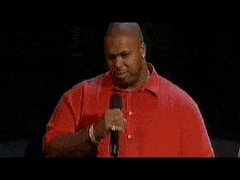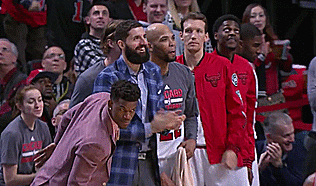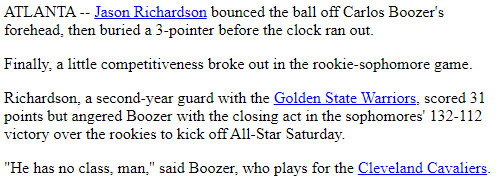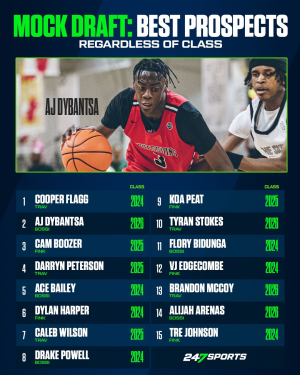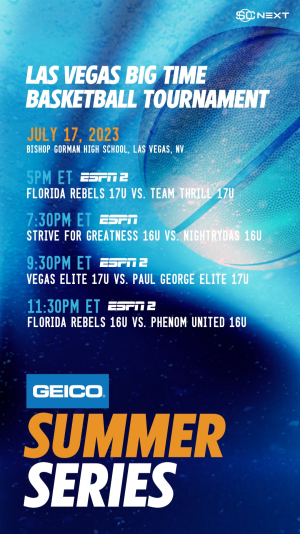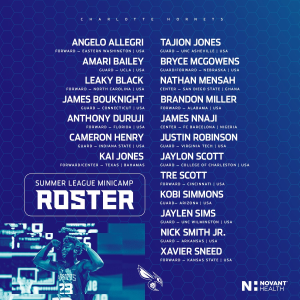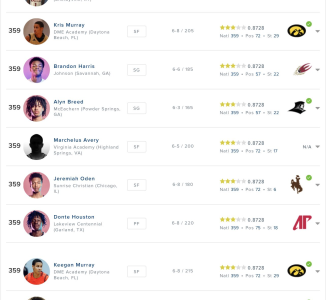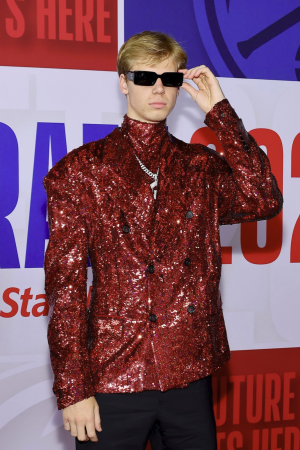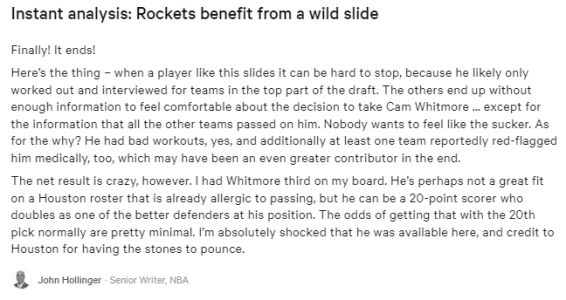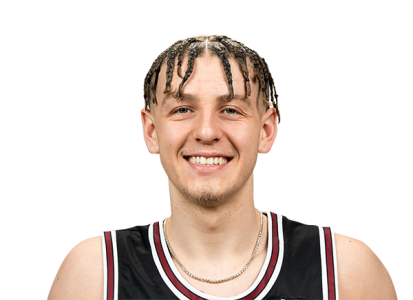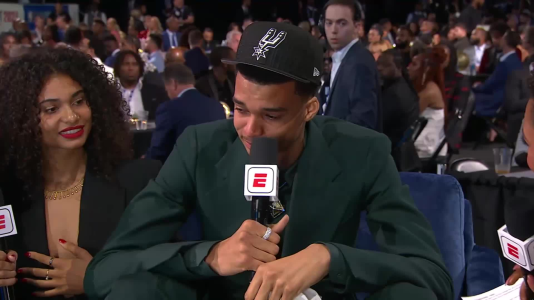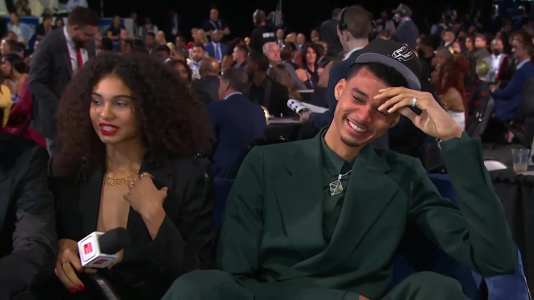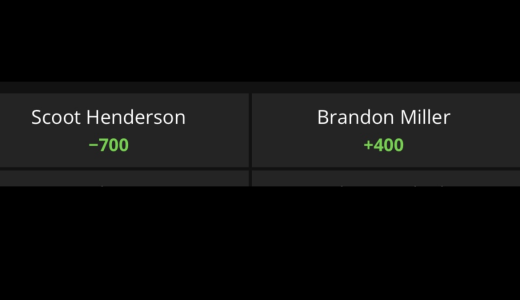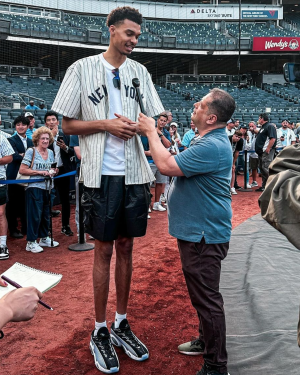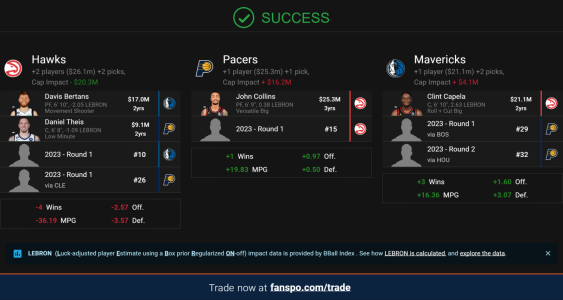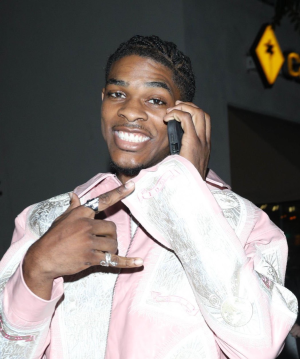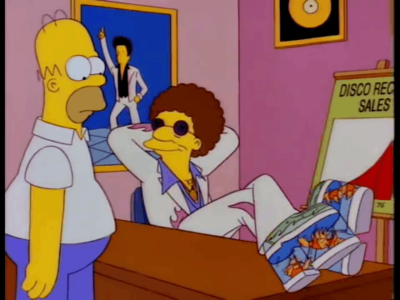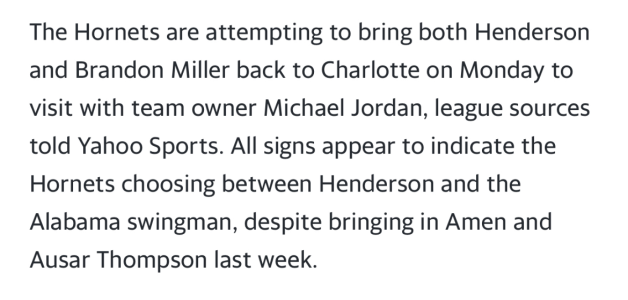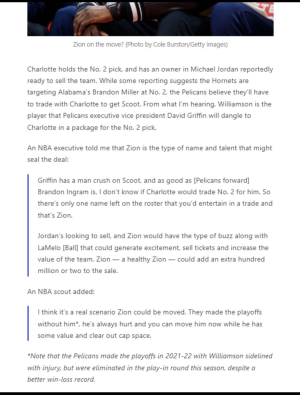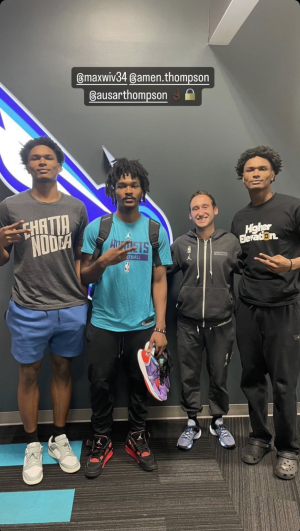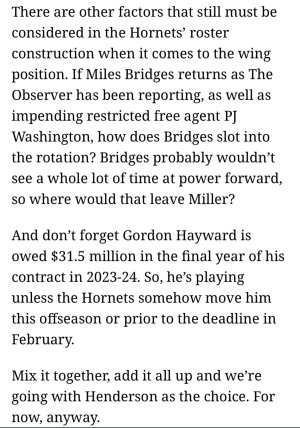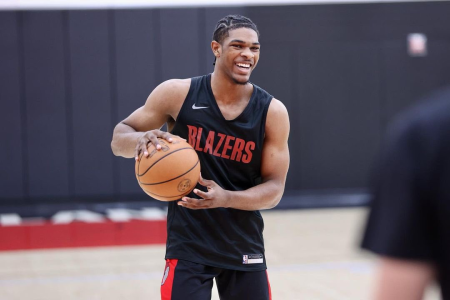- 85,482
- 111,580
- Joined
- Sep 5, 2010
10 returning NCAA players who’ve caught my eye for the NBA Draft
Who is the best returning prospect in college basketball?
That’s not an easy question this season. While everybody is excited about the 2023 NBA Draft, the top three projected players aren’t even playing in the NCAA. After that, we still have a paucity of returning prospects, even relative to recent years. Normally we get at least a couple of non-freshmen who rate as top-20 picks or better entering the season — think Purdue’s Jaden Ivey a year ago.
This season, not so much. The top 15 players on our Sam Vecenie’s most recent Big Board are either one-and-dones or not in NCAA basketball. Only four of his top 25 played in college basketball last season. Even compared to recent drafts that were dominated by freshmen, we’re in a much iffier landscape for returning players.
Nonetheless, at least a few had me intrigued heading into this season, either because I think they’ve been underrated by the masses or because I share in the excitement held by other draft watchers. Besides, every season, upperclassmen break through at the NBA level, and we realize we should have known better the whole time — think Desmond Bane from the 2020 draft or Herb Jones in 2021.
It may not be a great crop, but here are a few of the players who A) have me interested enough to keep an eye on through the season or B) I think I’m more bullish on than the median draftnik. (Ages listed are as of Dec. 1.):
Kris Murray, 22, 6-8 junior, SF, Iowa
You might have heard of his twin brother, Keegan, who was the fourth pick in the 2022 draft and is starting for the Sacramento Kings. Kris Murray won’t go fourth in the 2023 draft, but he has a great shot of being a first-rounder despite the fact that he will be 23 when the next NBA season starts.
Kris only played 18 minutes a game last season because, well, his awesome twin brother played the same position, but he’s putting up numbers so far this season that are shockingly similar to what Keegan did a year ago. The similarities in their games are rather obvious as well, with the exception that Kris is left-handed — but you can see the same natural scoring instinct and soft touch from all three levels. I don’t think it takes a rocket scientist to see a pro-caliber forward here.
Terrence Shannon, 22, 6-6 senior, SF, Illinois
I’ve been on the Terrence Shannon bandwagon since his freshman year at Texas Tech, while noting that he needed to develop his right hand and improve his outside shot to be a viable NBA wing. Well, it took a while, but voila.
Transferring to the Illini this season, he’s taken 34 3-pointers in six games and made 16 of them after gingerly stepping into 86 all season a year ago and converting a respectable 38.4 percent. He’s also a 78.1 percent career free-throw shooter, which helps make the 3-point numbers believable.
Meanwhile, Shannon has taken steps forward as a scorer and playmaker as well; scouts will be watching closely to see if it’s an early-season fluke or if he can maintain his surges in assists and 2-point shooting through the grueling Big Ten season. Like several other players on this list, Shannon is old enough that he’s unlikely to get the benefit of the doubt inside the top 20, but there’s a pro wing here.
Reece Beekman, 21, 6-3 junior, PG/SG, Virginia
OK, homer. Yes, Reece Beekman plays for my Wahoos, and he only averages 7.2 points per game in his career there. But let me assure you of one thing: Beekman is an NBA defender. While he’s a bit undersized for the two and his handle and creation ability don’t make him a huge threat on the ball, he’s averaging 4.0 steals per 100 possessions in a conservative defensive scheme in which only one other regular nabbed as many as 2.0 steals per 100 last season.
Additionally, Beekman’s offense has come a long way. An erratic shooter as a freshman, he’s made 8 of 14 3s and 19 of 22 free throws in six games this season and boosted his assist rate. Scouts will be looking especially hard at how he does on open catch-and-shoot 3s; knocking those down are the minimum standard for him to get minutes because of his defense. A quick slasher whose best moments are in Virginia’s rare transition opportunities, Beekman could also look a lot better offensively in an open NBA floor.
Colby Jones, 20, 6-5 junior, SG, Xavier
A longtime fave in these parts, Colby Jones might finally be turning the corner as a shooter. He’s opened the season making 9 of 14 3s and, more convincingly, 25 of his 29 free-throw attempts. After a hideous 29.2 percent from 3 and 68.0 percent from the line a year ago, that’s notable.
Jones offers a lot of positives otherwise. He has the size and athleticism to defend bigger players and is often asked to, but he also has the instincts and quickness of a guard, generating high steal rates and dropping off dimes on the move. His half-court offense is still a bit clunky, as he seems weirdly unable to get to a pull-up and can tie himself in pivoting knots when his drives are cut off. As a result, Jones’ overall scoring rate isn’t on par with some of the other prospects here. Nonetheless, as a young junior who will barely be 21 on draft day, Jones should be getting late first-round attention if the shooting uptick is real.
Josiah-Jordan James, 22, 6-6 senior, SF, Tennessee
I haven’t heard much talk about Josiah-Jordan James lately (and yes, the hyphen in his first name and not his last), but he offers a pretty enticing package. He’s only played three games this season but has played very well in them, and it continues a trend that he showed in the latter part of last season. Not renowned as a shooter, James made 21 of 42 3s last season in a late-season stretch, a fact everyone immediately dismissed when he went 0-for-6 in an upset NCAA Tournament loss to Michigan.
This season, he’s 10-of-19 from 3 and 5-for-5 from the line. Small sample and all, but that’s 31 of his last 67 3s over two seasons. And that matters because shooting was the only thing really separating James from being a strong prospect. He’s 6-6 and athletic, punching well above his weight as a rebounder (12.1 percent career rebound rate) and averaging over 3.0 steals and 2.0 blocks per 100 possessions over the past two seasons.
James doesn’t have the ballhandling wiggle to be a high-level scorer, and he’ll be 23 before the next NBA season starts, so we’re probably talking about a second-round prospect here. But if the shooting uptick is real, it’s pretty easy to envision a 3-and-D type landing for him in the pros.
Terquavion Smith, 19, 6-3 sophomore, SG, N.C. State
I’m not sure I’m as high on Terquavion Smith as some of my colleagues, but the rail-thin launcher has some clear pro potential. Smith has deep shooting range, but he’s also very quick and shown himself capable — at times — of disruptive defensive plays.
The biggest question, actually, is about how big a strength his shooting really is. Thus far, he’s profiled more as a mad bomber (an astounding 14.9 3-point attempts per 100) than a notably accurate one. He’s at 36.1 percent for his career and 32.1 percent on this young season. And if he’s such a good shooter, shouldn’t he be able to make a free throw? (70.9 percent career)
Those questions are important for Smith because the shooting is his pathway to the league. He’s badly undersized for the two, and his court vision and handle will need to improve for him to play point guard. Defensively, he’ll be a target. Nonetheless, his indicator stats are pretty good — high rates of steals and blocks for his size, a decent rebound rate and an assist rate that has nearly doubled in the early part of the season. He’s interesting as a Malik Monk type, instant offense sixth man.
Jalen Wilson, 22, 6-8 senior, SF, Kansas
I thought Jalen Wilson had played himself into the second round at the NBA Draft Combine and was surprised when he pulled his name out, but he may end up winning this bet. Wilson has erupted at the start of 2022-23, shooting 3s much more frequently (and accurately!) and also nearly doubling his scoring rate … not an easy feat when you were already arguably the best player on the national champion.
Wilson’s shooting will be scrutinized all season, as well as the rest of his game relative to younger players (he’s a 22-year-old senior), and those factors could still conspire to keep him out of the first round. But in a league that’s constantly scrounging for big, skilled wings, Wilson is a big wing who has demonstrated a notable uptick in skill.
Ricky Council IV, 21, 6-5 junior, SG, Arkansas
Ricky Council IV caught my eye in his freshman season at Wichita State; he had the athletic pop for shot creation that made you rewind the tape and say, “Wait, who was that guy?” His first two years in Wichita were a wild ride — there was a lot of shot creation and maybe not as much pass creation, and his outside shot isn’t consistent enough for him to survive on some of the jumpers he was taking.
That said, Council is clearly an NBA athlete, and there’s reason to believe he can shoot better than he’s shown thus far. He also rebounded like a four in two seasons in the AAC, and his “stocks” (steals and blocks) rates were a positive. With two likely lottery picks playing on the ball in Anthony Black and Nick Smith Jr., scouts will be watching how Council fits around them to get an idea of how he might fit as a role player at the next level.
Coleman Hawkins, 20, 6-10 junior, PF, Illinois
Yes, another player from Illinois. I don’t make the rules.
I’m not totally sure what this guy is yet, but I’m intrigued by him as a big guy who can create plays for others and maybe, hopefully, shoot? Coleman Hawkins only shot 29.2 percent from 3 last year and 65.0 percent from the line, but he’s off to a good start this season (8-for-21 from 3) and nearly doubled his assist rate from a year ago. He still doesn’t lack for warts for the nitpickers: You’d like to see more rebounding at his size, and he’s prone to both turnovers and fouls. Call this an eye-test call: I like his tools and think he has enough instincts for the game to get better. He’s probably more of a second-round guy, but he’s interesting.
(While we’re on the topic of Illinois, I easily could have put four players from that program on his list. Baylor transfer Matthew Mayer is a wild ride, and you’d like to see more progress in his 17th season of college basketball, but he has always intrigued me with his ability to create shots at one end and generate steals at the other. And sophomore R.J. Melendez somehow only played nine minutes a game last year even though statistically he might have been the team’s best player.)
Jaime Jaquez, Jr., 21, 6-6 senior, SG, UCLA
I’ve often felt that “knows how to play basketball” is an underrated line in a prospect’s resume. Jaquez Jr. is neither a freak athlete nor a threatening shooter, but he knows how to play basketball. While his career averages of 33.1 percent from 3 and 72.2 percent from the line are troubling, scouts can stake solace in Jaquez’s ability to read and react quickly to what’s happening around him on the court. He’s a deft passer, a crafty one-on-one scorer and a surprisingly disruptive defender for a player of this archetype.
Helpfully, he’s also young for a senior, not turning 22 until February, and that could help him compare favorably to some other wing candidates on this list. Jaquez could make that comparison easier, obviously, by knocking down a few more jumpers, but even if he shoots in the low 30s, there’s enough here to see a potential NBA role player.
Who is the best returning prospect in college basketball?
That’s not an easy question this season. While everybody is excited about the 2023 NBA Draft, the top three projected players aren’t even playing in the NCAA. After that, we still have a paucity of returning prospects, even relative to recent years. Normally we get at least a couple of non-freshmen who rate as top-20 picks or better entering the season — think Purdue’s Jaden Ivey a year ago.
This season, not so much. The top 15 players on our Sam Vecenie’s most recent Big Board are either one-and-dones or not in NCAA basketball. Only four of his top 25 played in college basketball last season. Even compared to recent drafts that were dominated by freshmen, we’re in a much iffier landscape for returning players.
Nonetheless, at least a few had me intrigued heading into this season, either because I think they’ve been underrated by the masses or because I share in the excitement held by other draft watchers. Besides, every season, upperclassmen break through at the NBA level, and we realize we should have known better the whole time — think Desmond Bane from the 2020 draft or Herb Jones in 2021.
It may not be a great crop, but here are a few of the players who A) have me interested enough to keep an eye on through the season or B) I think I’m more bullish on than the median draftnik. (Ages listed are as of Dec. 1.):
Kris Murray, 22, 6-8 junior, SF, Iowa
You might have heard of his twin brother, Keegan, who was the fourth pick in the 2022 draft and is starting for the Sacramento Kings. Kris Murray won’t go fourth in the 2023 draft, but he has a great shot of being a first-rounder despite the fact that he will be 23 when the next NBA season starts.
Kris only played 18 minutes a game last season because, well, his awesome twin brother played the same position, but he’s putting up numbers so far this season that are shockingly similar to what Keegan did a year ago. The similarities in their games are rather obvious as well, with the exception that Kris is left-handed — but you can see the same natural scoring instinct and soft touch from all three levels. I don’t think it takes a rocket scientist to see a pro-caliber forward here.
Terrence Shannon, 22, 6-6 senior, SF, Illinois
I’ve been on the Terrence Shannon bandwagon since his freshman year at Texas Tech, while noting that he needed to develop his right hand and improve his outside shot to be a viable NBA wing. Well, it took a while, but voila.
Transferring to the Illini this season, he’s taken 34 3-pointers in six games and made 16 of them after gingerly stepping into 86 all season a year ago and converting a respectable 38.4 percent. He’s also a 78.1 percent career free-throw shooter, which helps make the 3-point numbers believable.
Meanwhile, Shannon has taken steps forward as a scorer and playmaker as well; scouts will be watching closely to see if it’s an early-season fluke or if he can maintain his surges in assists and 2-point shooting through the grueling Big Ten season. Like several other players on this list, Shannon is old enough that he’s unlikely to get the benefit of the doubt inside the top 20, but there’s a pro wing here.
Reece Beekman, 21, 6-3 junior, PG/SG, Virginia
OK, homer. Yes, Reece Beekman plays for my Wahoos, and he only averages 7.2 points per game in his career there. But let me assure you of one thing: Beekman is an NBA defender. While he’s a bit undersized for the two and his handle and creation ability don’t make him a huge threat on the ball, he’s averaging 4.0 steals per 100 possessions in a conservative defensive scheme in which only one other regular nabbed as many as 2.0 steals per 100 last season.
Additionally, Beekman’s offense has come a long way. An erratic shooter as a freshman, he’s made 8 of 14 3s and 19 of 22 free throws in six games this season and boosted his assist rate. Scouts will be looking especially hard at how he does on open catch-and-shoot 3s; knocking those down are the minimum standard for him to get minutes because of his defense. A quick slasher whose best moments are in Virginia’s rare transition opportunities, Beekman could also look a lot better offensively in an open NBA floor.
Colby Jones, 20, 6-5 junior, SG, Xavier
A longtime fave in these parts, Colby Jones might finally be turning the corner as a shooter. He’s opened the season making 9 of 14 3s and, more convincingly, 25 of his 29 free-throw attempts. After a hideous 29.2 percent from 3 and 68.0 percent from the line a year ago, that’s notable.
Jones offers a lot of positives otherwise. He has the size and athleticism to defend bigger players and is often asked to, but he also has the instincts and quickness of a guard, generating high steal rates and dropping off dimes on the move. His half-court offense is still a bit clunky, as he seems weirdly unable to get to a pull-up and can tie himself in pivoting knots when his drives are cut off. As a result, Jones’ overall scoring rate isn’t on par with some of the other prospects here. Nonetheless, as a young junior who will barely be 21 on draft day, Jones should be getting late first-round attention if the shooting uptick is real.
Josiah-Jordan James, 22, 6-6 senior, SF, Tennessee
I haven’t heard much talk about Josiah-Jordan James lately (and yes, the hyphen in his first name and not his last), but he offers a pretty enticing package. He’s only played three games this season but has played very well in them, and it continues a trend that he showed in the latter part of last season. Not renowned as a shooter, James made 21 of 42 3s last season in a late-season stretch, a fact everyone immediately dismissed when he went 0-for-6 in an upset NCAA Tournament loss to Michigan.
This season, he’s 10-of-19 from 3 and 5-for-5 from the line. Small sample and all, but that’s 31 of his last 67 3s over two seasons. And that matters because shooting was the only thing really separating James from being a strong prospect. He’s 6-6 and athletic, punching well above his weight as a rebounder (12.1 percent career rebound rate) and averaging over 3.0 steals and 2.0 blocks per 100 possessions over the past two seasons.
James doesn’t have the ballhandling wiggle to be a high-level scorer, and he’ll be 23 before the next NBA season starts, so we’re probably talking about a second-round prospect here. But if the shooting uptick is real, it’s pretty easy to envision a 3-and-D type landing for him in the pros.
Terquavion Smith, 19, 6-3 sophomore, SG, N.C. State
I’m not sure I’m as high on Terquavion Smith as some of my colleagues, but the rail-thin launcher has some clear pro potential. Smith has deep shooting range, but he’s also very quick and shown himself capable — at times — of disruptive defensive plays.
The biggest question, actually, is about how big a strength his shooting really is. Thus far, he’s profiled more as a mad bomber (an astounding 14.9 3-point attempts per 100) than a notably accurate one. He’s at 36.1 percent for his career and 32.1 percent on this young season. And if he’s such a good shooter, shouldn’t he be able to make a free throw? (70.9 percent career)
Those questions are important for Smith because the shooting is his pathway to the league. He’s badly undersized for the two, and his court vision and handle will need to improve for him to play point guard. Defensively, he’ll be a target. Nonetheless, his indicator stats are pretty good — high rates of steals and blocks for his size, a decent rebound rate and an assist rate that has nearly doubled in the early part of the season. He’s interesting as a Malik Monk type, instant offense sixth man.
Jalen Wilson, 22, 6-8 senior, SF, Kansas
I thought Jalen Wilson had played himself into the second round at the NBA Draft Combine and was surprised when he pulled his name out, but he may end up winning this bet. Wilson has erupted at the start of 2022-23, shooting 3s much more frequently (and accurately!) and also nearly doubling his scoring rate … not an easy feat when you were already arguably the best player on the national champion.
Wilson’s shooting will be scrutinized all season, as well as the rest of his game relative to younger players (he’s a 22-year-old senior), and those factors could still conspire to keep him out of the first round. But in a league that’s constantly scrounging for big, skilled wings, Wilson is a big wing who has demonstrated a notable uptick in skill.
Ricky Council IV, 21, 6-5 junior, SG, Arkansas
Ricky Council IV caught my eye in his freshman season at Wichita State; he had the athletic pop for shot creation that made you rewind the tape and say, “Wait, who was that guy?” His first two years in Wichita were a wild ride — there was a lot of shot creation and maybe not as much pass creation, and his outside shot isn’t consistent enough for him to survive on some of the jumpers he was taking.
That said, Council is clearly an NBA athlete, and there’s reason to believe he can shoot better than he’s shown thus far. He also rebounded like a four in two seasons in the AAC, and his “stocks” (steals and blocks) rates were a positive. With two likely lottery picks playing on the ball in Anthony Black and Nick Smith Jr., scouts will be watching how Council fits around them to get an idea of how he might fit as a role player at the next level.
Coleman Hawkins, 20, 6-10 junior, PF, Illinois
Yes, another player from Illinois. I don’t make the rules.
I’m not totally sure what this guy is yet, but I’m intrigued by him as a big guy who can create plays for others and maybe, hopefully, shoot? Coleman Hawkins only shot 29.2 percent from 3 last year and 65.0 percent from the line, but he’s off to a good start this season (8-for-21 from 3) and nearly doubled his assist rate from a year ago. He still doesn’t lack for warts for the nitpickers: You’d like to see more rebounding at his size, and he’s prone to both turnovers and fouls. Call this an eye-test call: I like his tools and think he has enough instincts for the game to get better. He’s probably more of a second-round guy, but he’s interesting.
(While we’re on the topic of Illinois, I easily could have put four players from that program on his list. Baylor transfer Matthew Mayer is a wild ride, and you’d like to see more progress in his 17th season of college basketball, but he has always intrigued me with his ability to create shots at one end and generate steals at the other. And sophomore R.J. Melendez somehow only played nine minutes a game last year even though statistically he might have been the team’s best player.)
Jaime Jaquez, Jr., 21, 6-6 senior, SG, UCLA
I’ve often felt that “knows how to play basketball” is an underrated line in a prospect’s resume. Jaquez Jr. is neither a freak athlete nor a threatening shooter, but he knows how to play basketball. While his career averages of 33.1 percent from 3 and 72.2 percent from the line are troubling, scouts can stake solace in Jaquez’s ability to read and react quickly to what’s happening around him on the court. He’s a deft passer, a crafty one-on-one scorer and a surprisingly disruptive defender for a player of this archetype.
Helpfully, he’s also young for a senior, not turning 22 until February, and that could help him compare favorably to some other wing candidates on this list. Jaquez could make that comparison easier, obviously, by knocking down a few more jumpers, but even if he shoots in the low 30s, there’s enough here to see a potential NBA role player.






